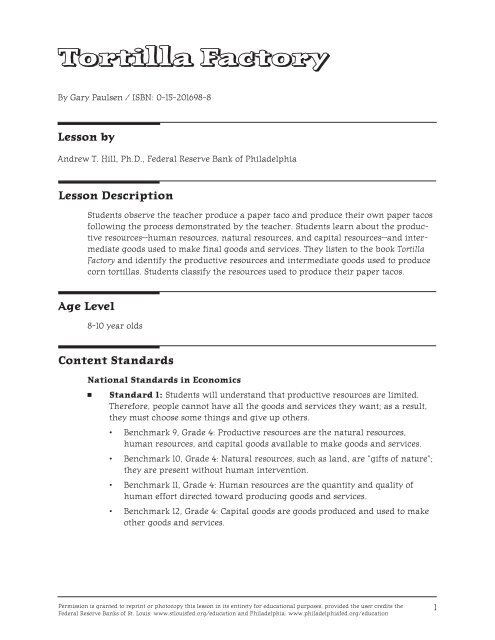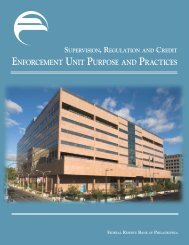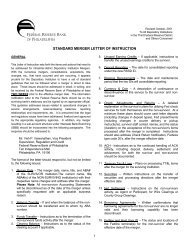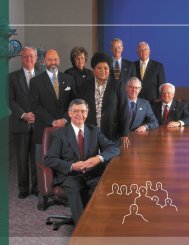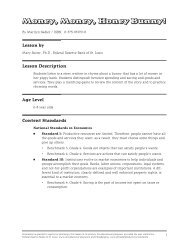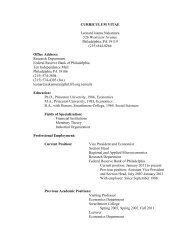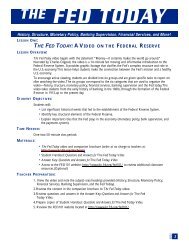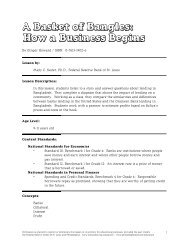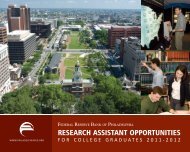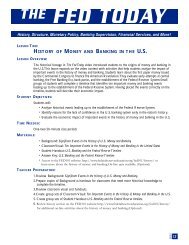Tortilla Factory - Federal Reserve Bank of St. Louis
Tortilla Factory - Federal Reserve Bank of St. Louis
Tortilla Factory - Federal Reserve Bank of St. Louis
Create successful ePaper yourself
Turn your PDF publications into a flip-book with our unique Google optimized e-Paper software.
<strong>Tortilla</strong> <strong>Factory</strong><br />
By Gary Paulsen / ISBN: 0-15-201698-8<br />
Lesson by<br />
Andrew T. Hill, Ph.D., <strong>Federal</strong> <strong>Reserve</strong> <strong>Bank</strong> <strong>of</strong> Philadelphia<br />
Lesson Description<br />
<strong>St</strong>udents observe the teacher produce a paper taco and produce their own paper tacos<br />
following the process demonstrated by the teacher. <strong>St</strong>udents learn about the productive<br />
resources—human resources, natural resources, and capital resources—and intermediate<br />
goods used to make final goods and services. They listen to the book <strong>Tortilla</strong><br />
<strong>Factory</strong> and identify the productive resources and intermediate goods used to produce<br />
corn tortillas. <strong>St</strong>udents classify the resources used to produce their paper tacos.<br />
Age Level<br />
8-10 year olds<br />
Content <strong>St</strong>andards<br />
National <strong>St</strong>andards in Economics<br />
■ ■ <strong>St</strong>andard 1: <strong>St</strong>udents will understand that productive resources are limited.<br />
Therefore, people cannot have all the goods and services they want; as a result,<br />
they must choose some things and give up others.<br />
• ∑Benchmark 9, Grade 4: Productive resources are the natural resources,<br />
human resources, and capital goods available to make goods and services.<br />
• ∑Benchmark 10, Grade 4: Natural resources, such as land, are “gifts <strong>of</strong> nature”;<br />
they are present without human intervention.<br />
• ∑Benchmark 11, Grade 4: Human resources are the quantity and quality <strong>of</strong><br />
human effort directed toward producing goods and services.<br />
• ∑Benchmark 12, Grade 4: Capital goods are goods produced and used to make<br />
other goods and services.<br />
Permission is granted to reprint or photocopy this lesson in its entirety for educational purposes, provided the user credits the<br />
<strong>Federal</strong> <strong>Reserve</strong> <strong>Bank</strong>s <strong>of</strong> <strong>St</strong>. <strong>Louis</strong>: www.stlouisfed.org/education and Philadelphia: www.philadelphiafed.org/education<br />
1
<strong>Tortilla</strong> <strong>Factory</strong><br />
Concepts<br />
Productive resources<br />
Natural resources<br />
Human resources<br />
Capital resources<br />
Intermediate goods<br />
Objectives<br />
<strong>St</strong>udents will:<br />
1. Define productive resources as capital resources, human resources, and natural<br />
resources.<br />
2. Define capital, human, and natural resources.<br />
3. Define intermediate goods.<br />
4. Classify the resources used in a production process as capital resources, human<br />
resources, natural resources, or intermediate goods.<br />
Time Required<br />
60 minutes<br />
Materials<br />
■■<br />
■■<br />
■■<br />
■■<br />
■■<br />
■■<br />
■■<br />
■■<br />
■■<br />
Copy <strong>of</strong> <strong>Tortilla</strong> <strong>Factory</strong> by Gary Paulsen<br />
Copy <strong>of</strong> Visual 1<br />
A copy <strong>of</strong> Handout 1 for each student and one for the teacher, cut apart and<br />
paper clipped together<br />
A copy <strong>of</strong> Handout 2 for each student<br />
One paper plate for each student<br />
Green, yellow, red, and brown crayons, one for each student and one for the<br />
teacher<br />
Scissors, one per student and one for the teacher<br />
Glue sticks, one per student and one for the teacher<br />
Large paper clips, one per student and one for the teacher<br />
Permission is granted to reprint or photocopy this lesson in its entirety for educational purposes, provided the user credits the<br />
<strong>Federal</strong> <strong>Reserve</strong> <strong>Bank</strong>s <strong>of</strong> <strong>St</strong>. <strong>Louis</strong>: www.stlouisfed.org/education and Philadelphia: www.philadelphiafed.org/education<br />
2
<strong>Tortilla</strong> <strong>Factory</strong><br />
Procedures<br />
1. Ask students if they have ever eaten a taco. (Answers will vary.) Have the students<br />
that have eaten a taco explain what the ingredients are in a taco and record<br />
those ingredients on the board. (Answers will vary but will likely include flour tortilla,<br />
hard corn tortilla, chicken, beef, seafood, cheese, taco sauce, lettuce, hot peppers.)<br />
2.<br />
Tell students that you are going to show them how to make a paper taco and<br />
then they will have a chance to make their own paper tacos using the process<br />
you demonstrate. Explain that the paper tacos the class will be making will represent<br />
chicken tacos.<br />
3.<br />
As the students watch, demonstrate how to make the paper taco.<br />
• Show students the paper plate. Explain that the paper plate will represent a<br />
flour tortilla. There are two basic kinds <strong>of</strong> tacos. Hard tacos are usually made<br />
with corn tortillas that have been crisped in hot oil. S<strong>of</strong>t tacos are made with<br />
flour tortillas. Fold the paper plate in half.<br />
• Show students the cheese wedge card. Explain that the cheese wedge will<br />
represent the shredded cheese used in real tacos. Use the yellow crayon to<br />
color the cheese wedge and cut it out using the scissors.<br />
• Show students the tomato card. Explain that the tomato will represent the<br />
chopped tomato used in real tacos. Use the red crayon to color the tomato and<br />
cut it out.<br />
• Show students the lettuce card. Explain that the lettuce wedge will represent<br />
the shredded lettuce used in real tacos. Use the green crayon to color the lettuce<br />
and cut it out.<br />
• Show students the chicken card. Explain that the chicken will represent<br />
the chopped chicken used in real tacos. Use the brown crayon to color the<br />
chicken and cut it out.<br />
• Open the folded paper plate and show the students how to use the glue stick<br />
to attach the cheese wedge, tomato, lettuce, and chicken to the inside <strong>of</strong> the<br />
paper plate.<br />
• Fold the paper plate closed and paper clip it along the edge to keep it closed.<br />
Permission is granted to reprint or photocopy this lesson in its entirety for educational purposes, provided the user credits the<br />
<strong>Federal</strong> <strong>Reserve</strong> <strong>Bank</strong>s <strong>of</strong> <strong>St</strong>. <strong>Louis</strong>: www.stlouisfed.org/education and Philadelphia: www.philadelphiafed.org/education<br />
3
<strong>Tortilla</strong> <strong>Factory</strong><br />
4.<br />
Display Visual 1. Distribute one set <strong>of</strong> cards from Handout 1, a paper plate, one<br />
crayon <strong>of</strong> each color (green, yellow, red, and brown), a pair <strong>of</strong> scissors, and<br />
a glue stick to each student. Tell the students to make their own paper tacos<br />
according to the process you demonstrated and directions outlined on the visual.<br />
Give the students time to work on their tacos.<br />
5.<br />
Tell students that producers use many different things to make all <strong>of</strong> the goods<br />
and services we consume. Explain to the students that productive resources<br />
are the natural resources, human resources, and capital resources used to make<br />
final goods and services.<br />
6. Explain that natural resources, such as land, are “gifts <strong>of</strong> nature”; they are<br />
present without human intervention. Explain that there are many different natural<br />
resources used by producers. Discuss the following:<br />
• What are some examples <strong>of</strong> natural resources? (Land, water, oil, sunlight,<br />
trees.)<br />
• What is the primary natural resource used in producing gasoline? (Oil.)<br />
• What are some natural resources used in producing vegetables? (Land, sunshine,<br />
water, seeds.)<br />
• What are some natural resources used in producing milk? ( Cows, land,<br />
animal feed.)<br />
• What are some natural resources used at school? (Land, sunlight, water.)<br />
7. Explain that human resources are the quantity and quality <strong>of</strong> human effort<br />
directed toward producing goods and services. All <strong>of</strong> the people who produce<br />
the goods and services we consume are called human resources. Discuss the<br />
following:<br />
• What are some examples <strong>of</strong> human resources? (Answers will vary but may<br />
include doctors, barbers, sales clerks, and teachers.)<br />
• What do we call the human resources that bake bread? (Bakers.)<br />
• What kind <strong>of</strong> resources are the farmers who grow vegetables? (Human<br />
resources.)<br />
• What human resources are used at school? (Answers will vary but may include<br />
teachers, custodians, secretaries, and principals.)<br />
Explain that<br />
8. capital resources are the tools, equipment, and buildings used<br />
to make other goods and services. Every good used over and over again to make<br />
other goods and services is called a capital resource. Discuss the following:<br />
Permission is granted to reprint or photocopy this lesson in its entirety for educational purposes, provided the user credits the<br />
<strong>Federal</strong> <strong>Reserve</strong> <strong>Bank</strong>s <strong>of</strong> <strong>St</strong>. <strong>Louis</strong>: www.stlouisfed.org/education and Philadelphia: www.philadelphiafed.org/education<br />
4
<strong>Tortilla</strong> <strong>Factory</strong><br />
• What are some examples <strong>of</strong> capital resources? (Answers will vary but may<br />
include factories, computers, robots, hammers, desks, and chairs.)<br />
• What are some capital resources used in baking a cake? (Mixer, spoon, bowl,<br />
baking pan, oven, cooling racks.)<br />
• What are some capital resources used at school? (Answers will vary but may<br />
include school building, desk, chairs, rulers, textbooks, and computers.)<br />
9. Explain that intermediate goods are goods that were previously produced<br />
and are used up in the production <strong>of</strong> new goods and services.<br />
• What are some intermediate goods used to build houses? (Lumber, nails,<br />
toilets, sinks, cabinets, ro<strong>of</strong>ing materials.)<br />
• What are some intermediate goods used to make books? (Paper, ink,<br />
cardboard.)<br />
• What are some intermediate goods used at school? (Paper, crayons, and pencils.)<br />
10. Tell students that you are going to read a book, <strong>Tortilla</strong> <strong>Factory</strong>, by Gary Paulsen.<br />
Show the cover. Ask them to listen carefully for all <strong>of</strong> the productive resources<br />
used to produce the tortillas. Read the book.<br />
11.<br />
Discuss the following:<br />
• From the beginning <strong>of</strong> the story until the tortillas reach the kitchen, what<br />
natural resources were mentioned in the story? (Black earth, yellow seeds, corn,<br />
hot sun.)<br />
• What additional natural resource is not mentioned in the story but would be<br />
needed in order for the corn to grow? (Water.)<br />
• In the story, who uses the flour and machinery to make dough? (Workers in<br />
the tortilla factory.)<br />
• What adjective was used to describe the people that work in the factory?<br />
(Laughing.)<br />
• What adjective was used to describe the machinery that mixes the flour into<br />
dough? (Clank-clunking.)<br />
• What do the factory workers do after they mix the dough? (Push the dough,<br />
squeeze the dough, flatten the dough, bake the dough.)<br />
• What term do we use to describe the tortilla factory workers? (Human<br />
resources.)<br />
• What other human resources were used in the production <strong>of</strong> tortillas? (Farmers.)<br />
Permission is granted to reprint or photocopy this lesson in its entirety for educational purposes, provided the user credits the<br />
<strong>Federal</strong> <strong>Reserve</strong> <strong>Bank</strong>s <strong>of</strong> <strong>St</strong>. <strong>Louis</strong>: www.stlouisfed.org/education and Philadelphia: www.philadelphiafed.org/education<br />
5
<strong>Tortilla</strong> <strong>Factory</strong><br />
• What do we call the machinery used to bake the tortillas and the factory?<br />
(Capital resources.)<br />
• Show the students the picture early in the book <strong>of</strong> the farmer using a hoe.<br />
What kind <strong>of</strong> tool is the farmer using to work the black earth? (Hoe.) How<br />
would we classify the hoe? (Capital resource.)<br />
• What intermediate good is used in the production <strong>of</strong> dough? (Flour.) Explain<br />
that the flour is an intermediate good because it was made from the corn<br />
and used up in the production <strong>of</strong> the dough. What intermediate good is<br />
used in the production <strong>of</strong> tortillas? (Dough.) The dough is an intermediate<br />
good because it was made from the flour and is used up in the production<br />
<strong>of</strong> the tortillas.<br />
• What happened to the tortillas after they arrived in the kitchen? (They were<br />
filled with beans and eaten by the workers who grew the corn.)<br />
12.<br />
Show the students the pictures <strong>of</strong> farming that appear on the pages after the<br />
tortillas are eaten. Discuss the following:<br />
• What capital resources appear in the pictures on these pages? (Shovel, tractor,<br />
planting attachment for the tractor, combine for harvesting corn, truck, silos.)<br />
• What natural resources appear on these pages? ( Earth, sunshine, corn.)<br />
• What human resources appear on these pages? (Farmers.)<br />
13.<br />
Have the students remove the paper clip from their paper tacos. Discuss the<br />
following:<br />
• What capital resources were used to produce the paper tacos? (Scissors, desks,<br />
chairs, school building.)<br />
• What human resources were used to produce the paper tacos? (<strong>St</strong>udents,<br />
teacher.)<br />
• What natural resources were used to produce the paper tacos? (Sunlight<br />
through the windows, land under the building.)<br />
• What intermediate goods were used to produce the paper tacos? (Paper plate,<br />
taco ingredient cards, crayons, paper clip, glue.)<br />
Permission is granted to reprint or photocopy this lesson in its entirety for educational purposes, provided the user credits the<br />
<strong>Federal</strong> <strong>Reserve</strong> <strong>Bank</strong>s <strong>of</strong> <strong>St</strong>. <strong>Louis</strong>: www.stlouisfed.org/education and Philadelphia: www.philadelphiafed.org/education<br />
6
<strong>Tortilla</strong> <strong>Factory</strong><br />
Closure<br />
14.<br />
Discuss the following:<br />
• What do we call the “gifts <strong>of</strong> nature” used to produce goods and services?<br />
(Natural resources.)<br />
• What do we call the quantity and quality <strong>of</strong> human effort directed toward<br />
producing goods and services? (Human resources.)<br />
• What do we call the tools, equipment, and buildings used to make other<br />
goods and services? (Capital resources.)<br />
• What do we call the goods previously produced and used up in the production<br />
<strong>of</strong> goods and services? (Intermediate goods.)<br />
15.<br />
Tell students to pretend that they are going to make a peanut butter and jelly<br />
sandwich for a friend. Discuss the following:<br />
• What capital goods would you use to make the peanut butter and jelly sandwich?<br />
(Knife, cutting board, kitchen counter.)<br />
• What human resources will be used to make the peanut butter and jelly sandwich?<br />
(<strong>St</strong>udents.)<br />
• What natural resources will be used to make the peanut butter and jelly<br />
sandwich? (Perhaps sunlight through the window.)<br />
• What intermediate goods will be used to make the peanut butter and jelly<br />
sandwich? (Bread, peanut butter, jelly.)<br />
Assessment<br />
16.<br />
Distribute a copy <strong>of</strong> Handout 2 to each student. Ask them to read the directions<br />
and complete the handout. Answers to the assessment:<br />
1. Natural<br />
2. Human<br />
3. Capital<br />
4. Intermediate<br />
5. Productive<br />
Natural Resources:<br />
Human Resources:<br />
Capital Resources:<br />
Intermediate Goods:<br />
sunlight, land under the house<br />
Eva<br />
knitting needles, pattern, chair, house<br />
yarn<br />
Permission is granted to reprint or photocopy this lesson in its entirety for educational purposes, provided the user credits the<br />
<strong>Federal</strong> <strong>Reserve</strong> <strong>Bank</strong>s <strong>of</strong> <strong>St</strong>. <strong>Louis</strong>: www.stlouisfed.org/education and Philadelphia: www.philadelphiafed.org/education<br />
7
<strong>Tortilla</strong> <strong>Factory</strong><br />
Visual 1: Paper Taco Directions<br />
■■<br />
■■<br />
■■<br />
■■<br />
■■<br />
■■<br />
■■<br />
■■<br />
■■<br />
■■<br />
■■<br />
■■<br />
■■<br />
Fold the paper plate in half.<br />
Color the cheese wedge yellow.<br />
Cut out the cheese wedge using the scissors.<br />
Color the tomato red.<br />
Cut out the tomato.<br />
Color the lettuce wedge green.<br />
Cut out the lettuce wedge.<br />
Color the chicken brown.<br />
Cut out the chicken.<br />
Unfold the paper plate.<br />
Glue the cheese wedge, tomato, lettuce wedge,<br />
and chicken to the inside <strong>of</strong> the paper plate.<br />
Refold the paper plate closed.<br />
Paper clip the paper plate along the edge to<br />
keep it closed.<br />
Permission is granted to reprint or photocopy this lesson in its entirety for educational purposes, provided the user credits the<br />
<strong>Federal</strong> <strong>Reserve</strong> <strong>Bank</strong>s <strong>of</strong> <strong>St</strong>. <strong>Louis</strong>: www.stlouisfed.org/education and Philadelphia: www.philadelphiafed.org/education<br />
8
<strong>Tortilla</strong> <strong>Factory</strong><br />
Handout 1: Taco Ingredient Cards<br />
Lettuce<br />
Tomato<br />
Cheese<br />
Chicken<br />
Permission is granted to reprint or photocopy this lesson in its entirety for educational purposes, provided the user credits the<br />
<strong>Federal</strong> <strong>Reserve</strong> <strong>Bank</strong>s <strong>of</strong> <strong>St</strong>. <strong>Louis</strong>: www.stlouisfed.org/education and Philadelphia: www.philadelphiafed.org/education<br />
9
<strong>Tortilla</strong> <strong>Factory</strong><br />
Handout 2: Assessment<br />
Name: ______________________________________________________________________________________<br />
Directions: Complete the sentences by filling in the correct answer in each blank in<br />
questions 1 to 5.<br />
1. __________________ resources are the “gifts <strong>of</strong> nature” used to produce goods and services.<br />
2. __________________ resources are the quantity and quality <strong>of</strong> human effort directed toward<br />
producing goods and services.<br />
3. __________________ resources are the tools, equipment, and buildings used to make other<br />
goods and services.<br />
4. __________________ goods are the goods previously produced and used up in the production<br />
<strong>of</strong> goods and services.<br />
5. __________________ resources are capital resources, human resources, and natural resources.<br />
Directions: Read the story in the box below and identify the natural resources, human<br />
resources, capital resources, and intermediate goods in the spaces below the story.<br />
.<br />
Eva decided to knit a new sweater. Eva went to the craft store and bought some yarn, knitting<br />
needles, and a pattern for the new sweater. When she returned home, she sat in her<br />
favorite chair in her house and knit the sweater, according to the pattern, in the sunshine<br />
coming through the window.<br />
Natural Resources<br />
Human Resources<br />
Capital Resources<br />
Intermediate<br />
Goods<br />
Permission is granted to reprint or photocopy this lesson in its entirety for educational purposes, provided the user credits the<br />
<strong>Federal</strong> <strong>Reserve</strong> <strong>Bank</strong>s <strong>of</strong> <strong>St</strong>. <strong>Louis</strong>: www.stlouisfed.org/education and Philadelphia: www.philadelphiafed.org/education<br />
10


